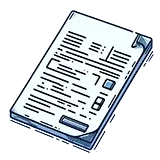Template of the Sales Receipt
A sales receipt is a proof-of-payment document issued immediately after a sale. It confirms that goods or services were sold and paid for, detailing the transaction for both buyer and seller.
What must a sales receipt include?
Using our online tool, you can issue a complete and professional sales receipt using the following components:
Basic Components:
Bill to – Full name and address of the customer.
Receipt number – A unique reference number for tracking.
Date – The date the transaction took place.
Description – Brief details about what was sold.
Amount – The total sum paid.
Advanced Components:
For more detailed receipts, you can also use:
Ship to – Delivery address (if different from billing).
Purchase Order (P.O.) – Customer’s internal order number.
Due date – Optional; mostly unused in immediate payment receipts.
Quantity – Number of units sold.
Unit price – Price per single unit of the item or service.

Always include a unique sales receipt number and date of issue to help both you and your customers keep accurate records. These details are essential for accounting and customer service.
When and why is it used?
Sales receipts are issued:
At the moment a product or service is paid for.
To give the customer legal proof of payment.
To keep records for business accounting and auditing.
To enable product returns, tax claims, or service validation.

